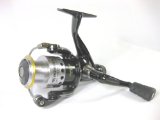

The basic coarse fishing tackle to get you startedWe are going to list here the basic coarse fishing tackle you will want to get if you are wanting to try a bit of fishing, but are not sure which technique you want to try. Note in this guide of basic coarse fishing tackle we are not going to cover pole fishing this is because pole fishing is basically a stand alone technique. If you are interested in giving pole fishing a go have a look here for a guide to the equipment you will need to get going. Also when it comes to freelining you need to use a centre pin reel which can be expensive, for a good reel - although this method can be done with a fixed spool reel, it is very difficult to do right and not get the line all tangled up on the spool. If you are going to try fishing it is better to try one of the other methods - namely float fishing, legering or lure fishing, as these are all done with a fixed spool reel. The Basic Coarse Fishing TackleFor the techniques we are going to cover here there are several pieces of basic coarse fishing tackle that are common to all of them - the rod, the reel, the line, the hooks and the weights. Although the types of these may change slightly for the different techniques it is possible to get one to allow you to try all of them. Of course this is not the ultimate list of coarse fishing tackle but a selection of gear to get you fishing. The RodGet a leger fishing rod - this will allow you to try all three methods, get a rod which is 12 to 13 feet long (3.6 to 3.9m) try to get a rod with at least 3 quiver tips - quiver tips are used when legering to detect bites. They can be used when fishing the other methods too, when lure fishing use the stiffest one you have, when you are float fishing you can use any of them, you will be watching the float for the bite. Try to get the rod in 3 sections. The ReelThe reel ? you will want a fixed spool reelTry to get a fixed spool reel with the following features:
Try and get a reel with most (if not all) of these features, also see if you can get an extra spool for it (a lot of the new reels coming out today come with an extra spool) having this option with your basic coarse fishing tackle makes it easy for you to have two setups ready to go, namely a setup for float fishing with a low breaking strain line and one with a heavier breaking strain line for lure fishing and legering, as these two methods can result in bigger strains on the line when casting, especially when feeder fishing, also they can result in bigger fish being hooked. The LineYou can get monofilment line to get started. Get two different breaking strain lines - one at 1Kg for float fishing and one at 4Kg for lure/leger fishing. Hooks Get a selection of hooks to cover the different techniques you are going to try. FloatsWhen getting your basic coarse fishing tackle get yourself two or three different types of floats to start off with. On the right we have wagglers these are good for still or slow flowing water. A waggler float, strictly speaking, is the term given to any float which is attached only at the bottom to the line.  Custom Search
Back to Freshwater Gear Back to Home 
|

























